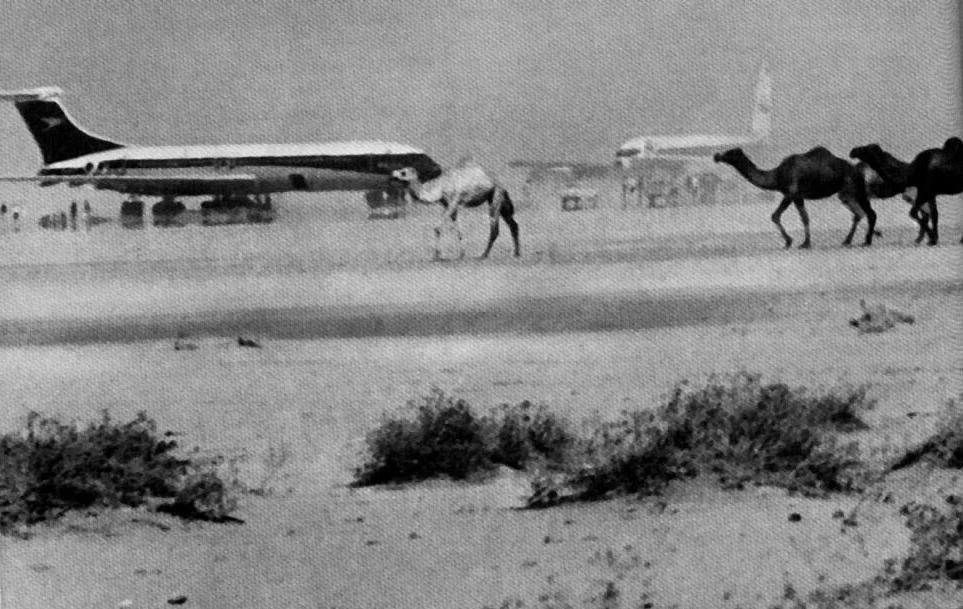
© Wikimedia CommonsDawson's Field in 1970
With so few clues in the case of Malaysia Airlines MH370, the theories surrounding the missing plane are taking on a life of their own. One widespread idea is that the plane may have flown to Central Asia somewhere, flying low to avoid the radar of multiple states (or simply exposing their radar systems' weakness). This theory, explained
very well by Jeff Wise over at Slate, uses satellite data that appears to indicate that the plane was heading north at 8:10 a.m. Malaysia time March 8, and could probably have ended up in Western China or somewhere nearby.
There's one very obvious reason this idea is enticing: It allows the possibility that the 239 passengers and crew on board the plane
could be alive. Few other theories, such as a terrorist attack, a pilot suicide or some kind of mechanical failure with the plane offer much hope there. It also seems to assume that that the plane was hijacked by crew or passengers.
It doesn't explain, however, the one thing that most high-profile hijackings, from the 1970s to the 2001 attacks on New York and Washington, have in common: Everyone knew what happened to the plane.
For example, think of the Dawson's Field hijackings in 1970. In that incident, the Popular Front for the Liberation of Palestine hijacked four planes, three bound for New York City and one for London, on Sept. 6, 1970. Two were flown to Dawson's Field in Jordan, a former British air force base now rebranded a "revolutionary airport," where they kept the passengers hostage, and when one attempted hijacking was foiled, members of the PFLP hijacked another plane and flew it to Beirut and then Cairo, where they eventually blew up the planes after evacuating everyone. A fifth plane was hijacked by a PFLP sympathizer a few days after the others and also flown to Dawson's Field.
The Dawson's Field hijackings were designed to be high-profile: Members of the media drove out to the Jordanian desert to attend "press conferences," and photographs from the scene show camels wandering past the hijacked jets. All non-Jewish passengers were released Sept. 11, and while the planes at Dawson's Field were blown up the next day, the remaining prisoners were eventually released a few weeks later. The only person who died was a member of the PFLP.
Dawson's Field was one of the most brazen hijacking events in an era of high-profile hijackings - it came a little over a year after January 1969, when eight planes flying to Cuba were hijacked in
one month, according to the Wall Street Journal. It was a short-lived era, however, as the gradual implementation of armed air marshals and other security measures led to a steep decline in the number of hijackings; the PFLP had almost entirely given up hijacking as a tactic within just a few years.
It wasn't until September 11, 2001, that a new era of air industry terrorism was ushered in. Until that date, the FAA had approved a tactic (known as "Common Strategy") for dealing with hijackings which was essentially: Talk with the hijackers, land the plane safely and let law enforcement deal with the demands of the hijackers. The goal was to get everyone off the plane alive. The attacks of 9/11 proved that this technique was ineffective when the hijackers' plans involve destroying the plane: Passengers were no longer a bargaining chip for the hijackers to hold and threaten (and in worst-case scenarios, kill), they were now individuals whose inevitable death could be used to shock, hurt and terrorize. New measures, such as armored doors on cockpits, were put in place.
The nature of hijacking has changed, but one thing hasn't: The need for publicity. The Dawson's Field hijackings were designed to be high-profile, and the hijackers had specific demands that they made known (largely the release of a number of Palestinian prisoners in Europe and the Middle East). Seven days after the hijacking, the world not only knew these demands, but were watching the hijackers blow up the planes on the evening news. Likewise, 9/11-style hijackings are, by definition, designed to be public events.
It's now been nine days since MH370 disappeared, and not only have we not heard any demands from anyone, but it seems that terrorist organizations seem to be going out of their way to say they didn't do it ("We wish we had an opportunity to hijack such a plane," one Pakistani Taliban
commander told Reuters). So far, few theories can explain that.
This is what gets me,
1) There is no gorilla thumping their chest declaring to the world that they have done this.
2) Some people have told Malaysia to "look here" while ignoring what was going on "over there" until what could cautiously be suggested that the coast was clear.
3) The plane was in a mobile reception area for an extended period.
4) Newspapers are saying the plane turned as many as three times.
5) With the hundreds of satellites that watch every single move humanity makes a plane can just disappear.
6) We triangulate the position of any mobile phone on the planet at any given time but cannot do the same for a pinging "handshake". Meanwhile, the company who operates the said satellites were not immediately alerted to focus their attention towards the issue.
8) Refuelling records are not publicly available allowing an accurate indication of the limit to how far the plane could travel.
7) Looking way beyond the aircraft's fuel limit to south western Australia, I don't think so.
Nothing in the media adds up and its over two weeks since the plane disappeared. The whole case is now shrouded in confusion forcing this case to be declared a mystery to be easily forgotten. All I can say is "convenient".